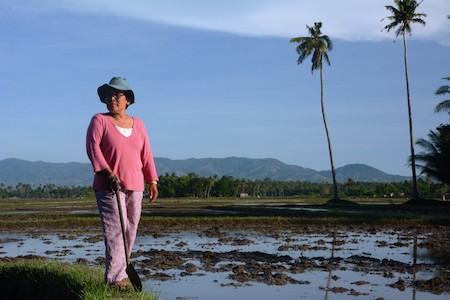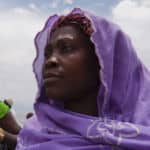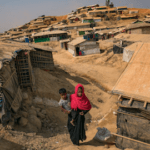Letter from Mindanao, Part 2: Rural banking and the promise of cacao
In part one of this post, Bruce MacDonald of the Center for Financial Inclusion at Accion discussed the potential impact of ASEAN Integration on banks in the Philippines, informed by his recent visit to the country. In part two below, he continues exploring the challenges and opportunities facing one of these institutions, 1st Valley Bank in Cagayan de Oro, Mindanao.
Though national bank liberalization has led commercial Philippine banks to acquire more rural and thrift banks, potentially increasing competition for 1st Valley, it has also provided the bank with a unique advantage. A 2013 amendment to the Rural Banking Act allowed foreign investment in Philippine banks which, in turn, permitted a new company called Bridge, led by American Paul Kocourek and Englishman Gus Poston, to invest in 1st Valley. Kocourek and Poston, both with deep regional banking experience, founded Bridge in order to help build a strong network of provincial Philippine banks committed to social impact. Identifying rural finance as the “missing component of inclusive banking,” their aim is to provide critical capital for growth, but also assistance in product design, risk management and more.
Bridge came to market in March of 2013 with $24 million in funding, provided by microfinance investment vehicles such as Bamboo Finance and national development banks such as the German DEG and Dutch FMO. (Full disclosure: Accion is also an investor and operating partner in Bridge.) 1st Valley was Bridge’s first investment, and remains its crown jewel. “The growth opportunities in [1st Valley’s] target markets are huge,” says Poston. “There are 1.3 million farms in the areas where 1st Valley operates, and the bank is only lending to 7,000 at the moment. To put it into perspective, Mindanao is about the size of Cambodia. There’s approximately $5 billion of microfinance lending in Cambodia. ‘Inclusive banking’ in Mindanao is smaller than a billion dollars.”
The Bridge investment has added substantial heft to the bank’s foundation and prospects, although no one underestimates the magnitude of the task ahead. While 1st Valley President and CEO Nicolas “Sonny” Lim lists bank liberalization and the threat of ASEAN integration among his concerns, Poston throws in a few more challenges. “Typhoons, land holding questions, security issues … we face specific barriers to lending in the Philippines,” he says. “1st Valley’s challenge is to continually improve its product offering, service quality and risk-management methodology so that it can reach more farmers and microfinance clients.”
Magic Beans
Bridge’s imprint can be seen and felt particularly in product development, helping to create tools such as new loans for poultry farmers and micro-insurance. But perhaps the most important new product is 1st Valley’s cacao loan.
Eighty to 90 percent of the world’s cacao (the raw ingredient in chocolate, cocoa butter and many other popular products) is produced by small, family-run farms – farms that must be no more than 15 to 20 degrees in latitude from the equator. Cacao, says Lim, can be grown in only 36 countries in the world – but it thrives in the soil and climate of the islands’ palm-shaded small holdings, and is productive within 18 to 24 months. That makes the Philippines ideally placed to help address a global cacao shortage that some say will reach a million metric tons by 2020. Since 1670 cacao has been a cash crop in the Philippines. By the 1980s, national production had reached 40,000 metric tons. By 2013, however, land reform and diseases had conspired to whittle that down to some 8,000 tons.
In response, the Department of Agriculture flagged cacao as a High Value Crop – a banner program created to help address food security, poverty alleviation and sustainable growth. Through the Philippine Cacao Challenge, the country committed to producing 100,000 metric tons by 2020, and has included cacao as part of its National Greening Program, an initiative to reforest the country. Mindanao, already delivering 90 percent of the country’s crop, was identified as ground zero.
A 1st Valley cacao loan provides borrowers up to 75,000 pesos ($1,600) over seven years. The bulk of the loan is delivered up-front, with two years’ grace given as the crop becomes established, initial installments reduced, and full installments required only during the last four years, as the plants become fully productive. To help ensure success, the bank partnered with Philippine agribusiness company Kennemer Foods International, which created a complete agricultural value chain for the smallholder farmer. This included seedlings, fertilizer, pest control, agronomy assistance and training – training not only for the growers, but also for bank staff. Farmers who follow their protocols, says Kennemer, will see their yields quadruple.
The support is typical – and timely. Mindanao is eight months into a widespread drought, the result of a powerful El Niño that has shaped Philippines weather for a year. Despite lower growth rates as a result, however, Poston reports that clients’ first cacao plantings are already producing pods.
He and Lim are forthright about the work ahead for 1st Valley: improved risk management, expansion into electronic channels, growth across all loan products and term deposit accounts. Expectations for microfinance and SME lending, in particular, are high – 7 million pesos ($150,000) per month for the microfinance portfolio, for example, or 80 percent growth year on year. And addressing delinquency, with the total outstanding balance of loans past due for more than 30 days currently at nearly 10 percent, is paramount.
There’s work for Bangko Sentral ng Pilipinas (BSP), too. “The central bank still has a lot of problems to solve, especially in the rural banking industry,” Lim says. While the number of rural banks has declined by a third in recent years, to around 650, he estimates that only 200 are profitable and healthy.
As for ASEAN integration, Poston evinces little concern. “We have to be realistic about the difference between rural banking and commercial banking,” he says. “1st Valley is targeting hard-to-reach rural clients and providing them with microfinance, SME and agricultural loans, which require totally different skill sets from other forms of banking. I don’t think there will be a major foreign competitor operating in rural Mindanao. Even the local banks are reluctant to expand in these areas.”
Road under Construction

Rice farmer and 13-year client of 1st Valley, Luz Hernando, Lala, Mindanao.
To get a true feel for 1st Valley, one must leave Cagayan de Oro and get out to the country. For two days we made our way west along Mindanao’s northern coast road, stopping to visit branches and clients en route. We met Discy Santiago, a first-grade teacher at Iligan City Central School, who took out a salary loan to cover her sister’s medical expenses. In Lala, we met rice farmers such as Luz Hernando (pictured left), whose supervised credit helps ensure that her 2.5-hectare tenant farm is as productive as possible. The loan addresses every phase of the production cycle, from fertilizer and seed through to a guaranteed buyer (1st Valley itself, if for any reason the farmer can’t sell their crops on the market – and at market price). “It’s like a family here,” Mimi Enad, the bank’s head of risk, told us.
The coast road itself is a work in progress. Pedestrians, motorbikes and cars wrangle and compete for space. Blind corners, high speeds, and games of “chicken” favor the nimble and strong of nerve. Cavernous potholes attest to the road’s importance; endless repaving projects emphasize the challenge. And every once in a while, for a brief second, comes a glimpse through the palms of the electric-blue Bohol Sea, like a travel poster advertising a reward for a job well done. Somewhere in there is a metaphor for 1st Valley.
The Philippines cast a long shadow in financial inclusion. To its credit go the earliest mobile money solutions, SmartMoney and GCash. The country perennially scores at the top of The Economist’s “Global Microscope” report, an annual assessment of enabling environments for financial inclusion. The BSP, among the most far-sighted, client-protection-friendly and highly regarded of central banks, keeps a sure hand on the levers of finance. It has always been a country to watch. And as Kocourek and Poston intended from the start, perhaps the Philippines is just the right place to address rural finance, that missing component of inclusive banking.
Photo credits: Bruce MacDonald
Bruce MacDonald is head of Communications and Operations for the Center for Financial Inclusion at Accion, a Washington D.C.-based think tank.
- Categories
- Uncategorized



